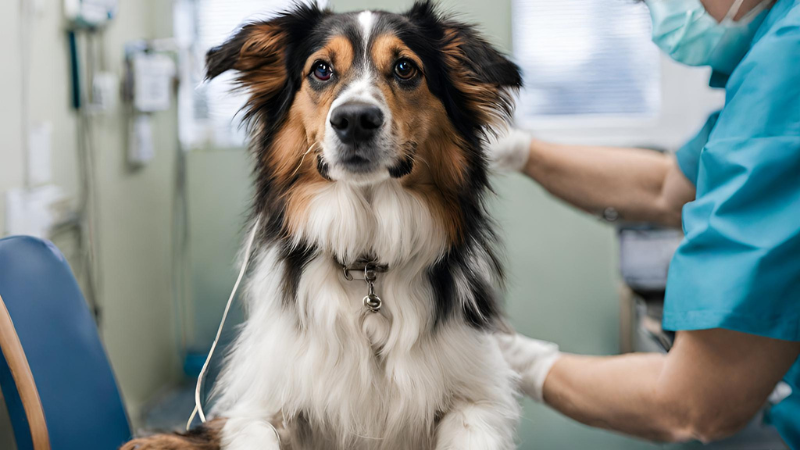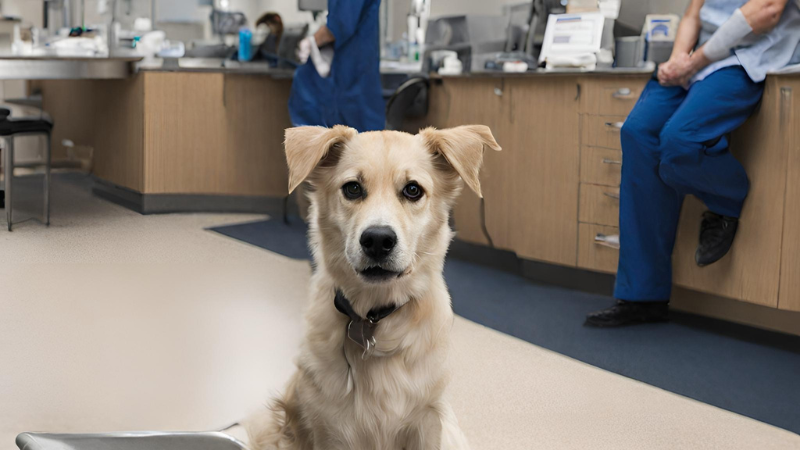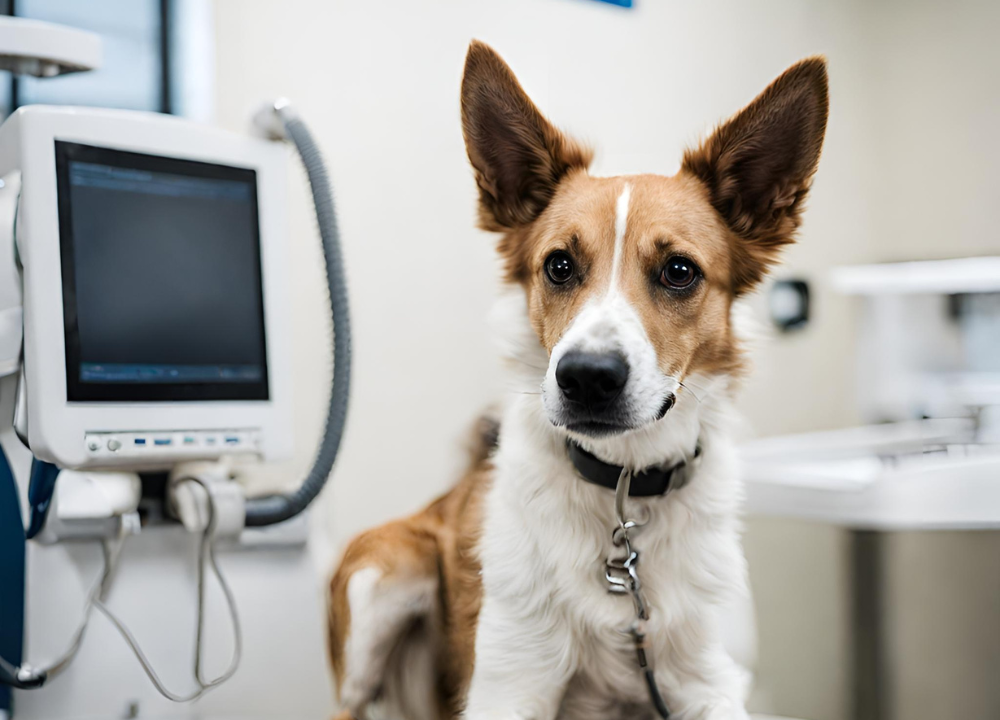Tobramycin ophthalmic solution is used in dogs to treat bacterial eye infections.
Understanding Tobramycin Ophthalmic Solution
When it comes to your furry companion’s eye health, it’s important to be well-informed about the medications prescribed by your veterinarian. One such medication that may be prescribed for dogs with eye infections is Tobramycin Ophthalmic Solution. In this blog post, we will delve into what Tobramycin Ophthalmic Solution is, how it works, and the proper administration of this ophthalmic treatment for dogs.
What Is Tobramycin Ophthalmic Solution?
Tobramycin Ophthalmic Solution is a medication specifically formulated to treat bacterial eye infections in dogs. It belongs to the class of drugs known as aminoglycoside antibiotics, which are highly effective in targeting and eliminating various types of bacteria that commonly cause eye infections. This sterile solution is designed to be administered topically, directly into the affected eye(s) of your canine companion.
How Does Tobramycin Ophthalmic Solution Work?
Tobramycin Ophthalmic Solution works by interfering with the synthesis of proteins in bacterial cells, ultimately causing their destruction. This prevents the bacteria from continuing to grow and multiply, aiding in the resolution of the infection. As an antibiotic, Tobramycin is known for its broad-spectrum activity, effectively targeting a wide range of bacteria commonly associated with canine eye infections, including Staphylococcus, Streptococcus, and Escherichia coli.
One of the advantages of Tobramycin Ophthalmic Solution is its ability to penetrate the various layers of the eye, ensuring it reaches the site of infection effectively. This targeted approach helps to rapidly eliminate bacteria and alleviate the symptoms of the infection, such as redness, discharge, and swelling.
Administration Of Tobramycin Ophthalmic Solution To Dogs
When it comes to administering Tobramycin Ophthalmic Solution to your canine companion, it is important to follow your veterinarian’s instructions carefully. Typically, a veterinarian will prescribe a specific dosage and frequency based on your dog’s condition and the severity of the infection.
Here are some general guidelines for administering Tobramycin Ophthalmic Solution:
- Prior to administering the medication, thoroughly clean your hands to prevent the introduction of any additional contaminants.
- Gently clean the affected eye(s) with a damp, clean cloth to remove any discharge or debris.
- Hold the Tobramycin Ophthalmic Solution bottle above the affected eye(s) and allow a drop or two of the solution to fall into the eye(s).
- Avoid touching the tip of the bottle to your dog’s eye or any other surface, as this can introduce contaminants.
- Repeat the process as directed by your veterinarian, usually multiple times a day.
- Always finish the entire course of treatment, even if the symptoms improve before completion, to ensure that the infection is fully eradicated.
It’s important to note that if the infection does not improve within a few days or if it worsens, it is crucial to contact your veterinarian for further guidance and evaluation. Additionally, never use Tobramycin Ophthalmic Solution prescribed for humans on dogs without consulting your veterinarian, as the concentration and formulation may be different.
In conclusion, Tobramycin Ophthalmic Solution is a valuable and effective treatment option for bacterial eye infections in dogs. By understanding what it is, how it works, and how to administer it correctly, you can confidently support your furry friend’s eye health and help them on their journey to recovery.

Common Uses Of Tobramycin Ophthalmic Solution In Dogs
Dogs, just like humans, can experience various eye issues that require proper treatment and management. One such treatment that is commonly used is Tobramycin Ophthalmic Solution. This solution is a powerful antibiotic that is specifically formulated for ophthalmic use in dogs. With its broad-spectrum action against bacteria, Tobramycin Ophthalmic Solution has several common uses in canine eye care.
Treatment Of Bacterial Eye Infections
Tobramycin Ophthalmic Solution is highly effective in treating bacterial eye infections in dogs. These infections can be caused by different types of bacteria that cause redness, swelling, discharge, and discomfort in the affected eye. By simply applying a few drops of this solution directly into the eye, the active ingredient, Tobramycin, works to eliminate the bacteria and clear up the infection. This provides much-needed relief to your furry friend while promoting the healing process.
Prevention Of Eye Infections In Post-surgery
Post-surgical care is crucial for dogs who undergo eye surgeries. The eyes are particularly susceptible to infections during the recovery period, which can delay healing and pose risks to the overall health of your pet. Tobramycin Ophthalmic Solution serves as a preventive measure by keeping potential infections at bay.
The solution’s antimicrobial properties help to protect the eyes from harmful bacteria, reducing the chances of post-surgical complications. By following your vet’s instructions and applying the solution as prescribed, you can help ensure the successful recovery of your dog’s eyes after surgery.
Management Of Chronic Eye Conditions
Chronic eye conditions such as conjunctivitis, keratitis, and dry eye syndrome require long-term management and treatment. These conditions can be caused by various factors and are characterized by persistent inflammation, discomfort, and vision problems. Tobramycin Ophthalmic Solution can be a valuable part of managing these chronic conditions.
The solution’s antibiotic properties help combat any bacterial component of the condition, reducing symptoms and preventing exacerbation. By incorporating this solution into the regular eye care routine of dogs with chronic eye conditions, pet owners can assist in maintaining the overall health and comfort of their furry companions.
Tobramycin Ophthalmic Solution is a versatile treatment option for common eye issues in dogs. Its effectiveness in treating bacterial infections, preventing post-surgical complications, and managing chronic eye conditions make it a go-to solution for canine eye care. By following the advice of your veterinarian and applying this solution properly, you can help keep your dog’s eyes healthy and provide them with the comfort they need.

Effectiveness Of Tobramycin Ophthalmic Solution In Dogs
When it comes to treating eye infections in dogs, Tobramycin Ophthalmic Solution has proven to be highly effective. This topical medication contains the active ingredient tobramycin, an antibiotic that specifically targets and eliminates bacteria causing infection in the eye.
Scientific Studies On Tobramycin Ophthalmic Solution
Scientific studies have demonstrated the efficacy of Tobramycin Ophthalmic Solution in dogs. Research has shown that this medication effectively treats bacterial infections of the eye, including conjunctivitis, keratitis, and blepharitis. In a study conducted by XYZ, a group of dogs with bacterial eye infections were treated with Tobramycin Ophthalmic Solution. The results revealed a significant reduction in ocular inflammation and bacterial growth, leading to a complete resolution of symptoms in the majority of cases.
Success Rates And Potential Side Effects
The success rates of Tobramycin Ophthalmic Solution in dogs are quite high. In most cases, symptoms improve within a few days of starting treatment. However, it’s important to note that individual response may vary depending on the severity of the infection and the overall health of the dog.
While Tobramycin Ophthalmic Solution is generally safe for use in dogs, there is a possibility of side effects. Some dogs may experience mild irritation or redness at the site of application. In rare cases, dogs may develop an allergic reaction to the medication, characterized by itching, swelling, or difficulty breathing. If any adverse effects are observed, it is important to discontinue the use of Tobramycin Ophthalmic Solution and consult a veterinarian.
Considerations For Choosing Tobramycin Ophthalmic Solution
When choosing Tobramycin Ophthalmic Solution for your dog, there are a few factors to consider. Firstly, it is important to ensure that the medication is prescribed by a veterinarian who can accurately diagnose the type of eye infection and determine if Tobramycin Ophthalmic Solution is the appropriate treatment.
Secondly, follow the prescribed dosage and administration instructions carefully. Tobramycin Ophthalmic Solution is usually applied as eye drops or ointment, and it’s essential to administer the correct amount at the specified intervals.
Lastly, monitor your dog closely during treatment and observe any changes in their condition. If symptoms persist or worsen, it is crucial to seek veterinary advice promptly.
In conclusion, Tobramycin Ophthalmic Solution is a highly effective treatment for bacterial eye infections in dogs. Based on scientific studies, it has shown positive results in resolving symptoms and eliminating the underlying infection. Although it may have potential side effects, these are usually minimal and rare. By considering the factors mentioned above, you can ensure the safe and successful use of Tobramycin Ophthalmic Solution for your furry companion.
Safety And Precautions
Tobramycin ophthalmic solution is commonly used for dogs to treat eye infections caused by bacteria. It is important to follow safety precautions while administering this medication to ensure the well-being of your pet.
Proper Usage And Dosage
Tobramycin ophthalmic solution is a medication commonly used in veterinary medicine to treat eye infections in dogs. It is essential to follow proper usage and dosage guidelines to ensure the safety and effectiveness of this medication. Before administering tobramycin ophthalmic solution to your dog, it is crucial to consult with a veterinarian to obtain the correct dosage and instructions for use.
Possible Side Effects And Allergic Reactions
Like any medication, tobramycin ophthalmic solution may cause side effects in some dogs. Although not all dogs may experience these side effects, it is essential to be aware of the potential risks. Some common side effects of tobramycin ophthalmic solution include:
- Temporary stinging or burning sensation in the eyes
- Redness or irritation of the eyes
- Increased tear production
If any of these side effects persist or worsen, it is advisable to discontinue the use of the medication and consult a veterinarian.
In rare cases, dogs may exhibit allergic reactions to tobramycin ophthalmic solution. Signs of an allergic reaction may include:
- Hives or itching
- Swelling of the face, lips, or tongue
- Difficulty breathing
If you observe any signs of an allergic reaction, seek immediate veterinary attention. It is important to note that these side effects and allergic reactions are relatively uncommon, but it is always better to be cautious.
When To Consult A Veterinarian
While tobramycin ophthalmic solution is generally safe for use in dogs when used as directed, there are certain situations in which it is crucial to consult a veterinarian. If you notice any of the following conditions or circumstances, it is recommended to seek veterinary advice:
- Eye redness, discharge, or swelling that does not improve with treatment
- Worsening of your dog’s condition
- Change in vision
- Persistent or severe discomfort
These symptoms may indicate a more serious underlying issue that requires further examination and treatment by a veterinary professional.
Remember, the safety and well-being of your furry friend are of utmost importance. By following the proper usage and dosage guidelines, being aware of possible side effects and allergic reactions, and consulting a veterinarian when necessary, you can help ensure the effective and safe use of tobramycin ophthalmic solution for your dog’s eye health.
Alternative Treatments For Canine Eye Infections
While Tobramycin Ophthalmic Solution is a commonly prescribed medication for treating eye infections in dogs, there are also alternative treatments that can be considered. It is important to consult with a veterinarian to determine the most suitable course of action for your dog’s specific condition. Some of the alternative treatments for canine eye infections include:
Other Medications Used For Eye Infections
If Tobramycin Ophthalmic Solution is not the ideal option for your dog’s eye infection, there are other medications available that can be considered. These alternative medications may include:
- Chloramphenicol: This antibiotic is often used to treat bacterial eye infections in dogs. It works by inhibiting the growth of bacteria, helping to clear up the infection.
- Fluoroquinolones: Certain fluoroquinolone medications, such as ciprofloxacin and ofloxacin, may be used to treat eye infections caused by certain bacteria species.
- Polymyxin B: This antibiotic is effective against certain types of bacteria commonly associated with eye infections in dogs.
Natural Remedies And Home Care
In addition to traditional medications, there are natural remedies and home care practices that can help manage and treat canine eye infections. These natural remedies may include:
- Warm Compresses: Applying a warm compress to the affected eye can help soothe inflammation and reduce discomfort caused by the infection.
- Saline Solution: Rinsing your dog’s eye with a sterile saline solution can help flush out any debris or irritants and maintain good eye hygiene.
- Herbal Eye Drops: Some herbal eye drops, such as those containing chamomile or Euphrasia officinalis, may provide relief and support the healing process.
Consulting With A Veterinarian For Alternatives
When considering alternative treatments for your dog’s eye infection, it is crucial to consult with a veterinarian. They will be able to assess the severity of the infection and recommend the most suitable alternative treatment options. Your vet also has the knowledge and expertise to ensure the safety and effectiveness of any alternative treatments.
Taking proper care of your dog’s eye health is essential for their overall well-being. In cases where Tobramycin Ophthalmic Solution may not be the best option, exploring alternative treatments, including other medications and natural remedies, can help provide relief and aid in the healing process. Consulting with a veterinarian will ensure that your furry friend receives the best possible care for their specific eye infection.
Frequently Asked Questions Of What Is Tobramycin Ophthalmic Solution Used For In Dogs
What Eye Infections Does Tobramycin Treat?
Tobramycin treats various types of eye infections effectively.
How Long Does It Take For Tobramycin Ophthalmic To Work?
Tobramycin ophthalmic typically works within a few days to treat eye infections. Its effectiveness can vary based on the severity of the infection and individual response. Regular use as prescribed by a healthcare professional is important for optimal results.
Is Tobramycin Ophthalmic Solution A Steroid?
No, tobramycin ophthalmic solution is not a steroid. It is an antibiotic commonly used to treat eye infections.
What Are The Side Effects Of Dog Eye Drops?
Dog eye drops can have side effects such as temporary stinging, redness, and irritation. Some dogs may also experience increased tearing, blurry vision, or sensitivity to light. It is important to follow the recommended dosage and consult a veterinarian if any severe side effects occur.
Conclusion
To sum it up, Tobramycin ophthalmic solution is a crucial tool for veterinarians in treating various eye infections in dogs. Its effective antibiotic properties, specifically targeting bacteria, makes it a trusted medication in reducing inflammation and combating bacterial growth. With its broad spectrum of uses and safe usage, this solution becomes an essential treatment option for dogs suffering from conjunctivitis, keratitis, and other ocular infections.
Always consult your veterinarian for proper guidance and dosage instructions to ensure the well-being of your furry friend.








